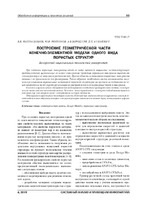| dc.contributor.author | Напрасников, В. В. | |
| dc.contributor.author | Полозков, Ю. В. | |
| dc.contributor.author | Бородуля, А. В. | |
| dc.contributor.author | Кункевич, Д. П. | |
| dc.coverage.spatial | Минск | ru |
| dc.date.accessioned | 2020-01-09T07:53:30Z | |
| dc.date.available | 2020-01-09T07:53:30Z | |
| dc.date.issued | 2019 | |
| dc.identifier.citation | Построение геометрической части конечно-элементной модели одного вида пористых структур = Building a geometric part finite element model of one kind of porous structures / В. В. Напрасников [и др.] // Системный анализ и прикладная информатика. – 2019. – № 4. – С. 55-61. | ru |
| dc.identifier.uri | https://rep.bntu.by/handle/data/62321 | |
| dc.description.abstract | При создании пористых материалов одной из задач является повышение теплоизолирующих свойств изделий, выполненных из таких материалов. Свойства пористого материала зависит от геометрии пор и их взаимного расположения. Другая область использования пористых материалов связана с их применением для фильтрации. Таким образом, необходимо иметь возможность получения результатов виртуальных испытаний пористой структуры на предмет исследования течения жидкости в этой структуре или картин распределения температурных полей в материале. И в том и в другом случаях для выполнения моделирования необходимо предварительно создать геометрическую часть конечно-элементной модели. Заметим, что в первой задаче геометрической областью является материал пор, а во втором случае – содержащаяся в порах жидкость. Описывается характерная последовательность действий при создании одного из вариантов геометрической модели таких объектов, которая с несущественными изменениями может быть использована и в других случаях. | ru |
| dc.language.iso | ru | ru |
| dc.publisher | БНТУ | ru |
| dc.title | Построение геометрической части конечно-элементной модели одного вида пористых структур | ru |
| dc.title.alternative | Building a geometric part finite element model of one kind of porous structures | ru |
| dc.type | Article | ru |
| local.description.annotation | When creating porous materials, one of the tasks is to increase the insulating properties of products made from such materials. The properties of the porous material depends on the geometry of the pores and their relative position. Another area of use of porous materials is associated with their use for filtration. Thus, it is necessary to be able to obtain the results of virtual tests of the porous structure for the study of fluid flow in this structure or patterns of the distribution of temperature fields in the material. In both cases, to perform the simulation, you must first create the geometric part of the finite element model. Note that in the first problem, the geometric region is the material of the pores, and in the second case, the liquid contained in the pores. | ru |

